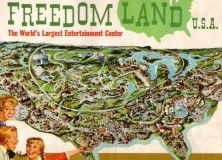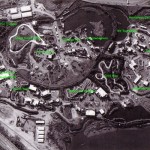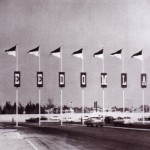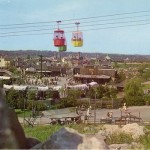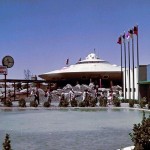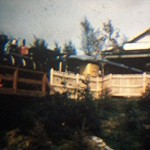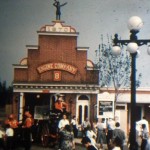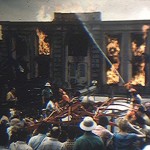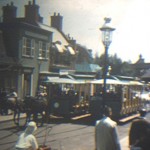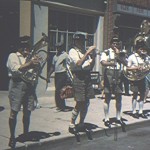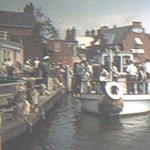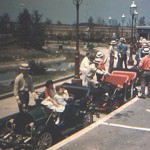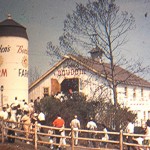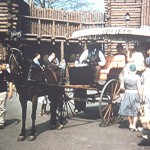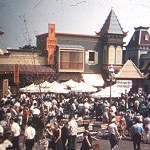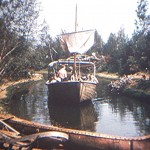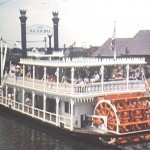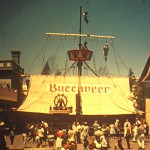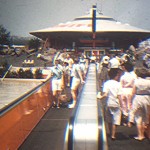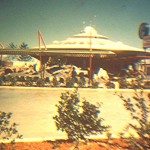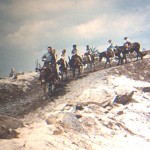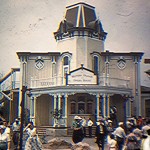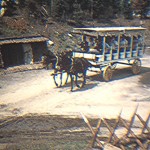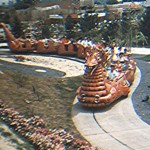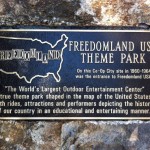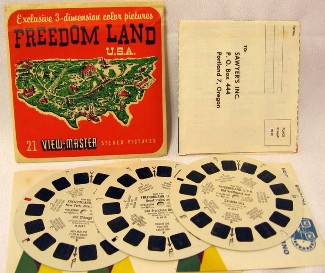 Yesterday, I opened a gift from my younger sister. She sent it to me all the way from across the country with the words, “Don’t open until Christmas!” tagged to the wrapping paper.
Yesterday, I opened a gift from my younger sister. She sent it to me all the way from across the country with the words, “Don’t open until Christmas!” tagged to the wrapping paper.
We’re not into exchanging gifts, now that our kids are adults, so it caught me unaware and I called her to admonish her for spending the money to ship whatever it was and the fact that I didn’t send her anything. She assured me it was nothing special – just something she came across after our mother passed away and she thought I might like some memories of a childhood long past.
I actually did wait until Christmas to open it. Inside was an old View-Master from the 1950’s that had been shared with 5 siblings through the 1960’s and a number of View-Master reels were included. I hadn’t seen those things for at least 40 years and why my mother kept them I can only guess was her own sentimental memories of her children when we were all… well, children – and not the opinionated adults we became.
It’s funny how things you completely forget can come back in an instant. The reel with the missing mini-photo on one side because I was determined at the age of 6 or 7 to find out the secret of pictures being seen in 3D. I had some pissed off siblings when they found that reel. A $1.25 for a packet of three reels was hard to come by for us.
There are a lot of titles among these reels. Roy Rogers, Daniel Boone, Land of The Giants, Voyage To The Bottom of The Sea, Mary Poppins, Quick Draw McGraw, Chilly Willy, among the many others I have in front of me.
And kids today think an XBOX is cool.
One packet caught my eye that I had no memory of.
Freedomland USA. Looking at the packet cover didn’t spark a memory of the place, or ever having viewed the reels.
It was only when I began looking at the images inside that View-Master that I began recalling some brief memories of having visited the park. I couldn’t have been older than 5, because it closed when I was that age. I remembered a fear of riding in a bucket that allowed a view high above the park. The Chicago building fire. The stage coach and being told that I was too small to ride on top of it. Elsie the Cow and the Borden’s Farm. A flash of an image of riding on the paddle boat, here. A gunfighter shooting an outlaw in a fort, there. The Indian Village. A lot of it returned.
I did remember it was fun until one distinct memory surfaced.
Not all was great that day. My oldest brother holding me down in the roller coaster seat until the ride stopped, because nobody realized the bar that went across us both was tight across his overweight 15 y/o lap, but failed to press down on my own child sized lap. At one point my knees were above that bar and my brother was keeping me from falling out of that ride and down in that bench seat, by holding onto my belt. My screams and pleas for help to my brother began over the first hump, as I felt myself being lifted up and out. I didn’t stop until the ride ended.
Absolutely true story and I apparently suppressed it for decades, putting the entire day in the vault with it.
I now know why I hate roller coasters, even though I thought I had never ridden one. Something that was always curious to me, because I’ve gone on far scarier rides with a yawn.
On the bright side, I can now cancel that psychiatrist appointment and shock therapy session next week.
Freedomland USA was the answer to every lower middle class family having no prospect of ever seeing Disneyland. Adults were charged a $1.00 for admission and kids paid 50 cents. Every long once in awhile, when my Old Man sobered up, he would have some guilt and the family had a great day. That was one of them. For $5, our family of 8 went to “The World’s Largest Entertainment Center” and still had money for each child to buy a souvenir.
Those of you who are old enough may remember Freedomland USA. It was the East Coast’s answer to Disneyland.
It was designed by Cornelius Vanderbilt Woods, who was hired by Walt Disney in 1953. Woods selected the Anaheim, CA site, designed Disneyland, and became Vice President of Operations for Walt Disney before being fired abruptly in 1956 due to a falling out between the two men that still remains conjecture regarding the true reason. Some say Walt didn’t like Woods claiming credit for Disneyland in the media, others say Walt got wind of Woods designing parks for others, that would compete against Disneyland.
To this day, Disney attributes no credit for Disneyland to Woods.
Woods immediately set out designing and creating amusements parks throughout areas of the US. Probably his most ambitious was Freedomland USA. He found a major investor and having control of more than 200 acres in Bronx, NY, they began building the amusement park that was estimated would cost $16 million. The final price tag upon it’s opening on June 18, 1960 ended up being more than $60 million.
The amusement park itself was built on 85 acres, larger than Disneyland’s 65 acres and the borders of the park had a fair resemblance to the continental United States. The theme was a history of the US with areas of the park intended to highlight that part of the country with related attractions.
It was a more than respectable answer to Disneyland, but unlike Disneyland that had the backing of ABC Studios, as well as Walt Disney’s own wealth, Freedomland USA had no additional money resource other than ticket sales and advertisers sponsorship. It also had a shorter season than sunny California. Before it opened its doors it was already millions of dollars in debt and things only got worse.
A week after opening, the stage coach overturned when the horses were spooked by the passing train ride (which the driver forewarned was a possibility and asked the route be changed, but was ignored). 10 people were seriously injured. One with a cracked spine and lawsuits followed.
If you had been a visitor at the park on August 28th of that year you would have been treated to two robberies that day. Actors made their appearance at a scheduled fake bank robbery, while only a short distance away the box office was being robbed by real felons with real guns, who stole more than $28,000 in cash.
Freedomland USA never made a profit and the final nail in its coffin arrived with The 1964 World’s Fair in New York, according to the bankruptcy filed by Freedomland USA. Though, many believe it was used as a convenient opportunity in turning a precarious venture with an unsure future into a quick profit for all investors and Woods, by opening the door for a land sale, while eliminating much of the debt being carried.
The land was quickly sold to developers who just as quickly tore down the amusement park. They built a housing community and shopping center on the land. That community is known as Co-Op City and those who reside within the 15,000 residential units shop at their Bay Plaza Shopping Mall. Children attend 3 schools built to serve the residents of Co-Op City. To give you an idea of the size of it all, if you were to lift Co-Op City out of New York City’s boundaries and it became independent, it would be the 15th largest city in New York state.
But what a park it was, when it was!
If you were there, see how many of these attractions and areas you remember:
- Little Old New York (1850-1900)
- Grape Juice Bar – A beverage bar
- Harbor Tug Boats – A boat ride through the Great Lakes
- Horse-Drawn Streetcar – A transportation ride to the Chicago area
- Horse-Drawn Surrey – A transportation ride to the Chicago area
- Horseless Carriage – An antique car ride in a 1909 model Cadillac through a mock-up of New England
- Ice Cream Parlor – Ice cream parlor designed in an 1890’s style
- Political Pep Rally – A live street show that included a German Band, an 1880’s Tammany speech, rallying suffragettes and a New York gangland robbery of the Little Old New York Bank
- R.H. Macy – “A recreation of the first store in Macy*s department store chain.”
- Schaefer’s Brewery – An old-fashioned brewery sponsored by Schaefer Beer
- Shuntz’s Delicatessen – Served New York style Pastrami and Corned Beef Sandwiches with Cheesecake for desert.
- Chicago (1871)
- The Chicago Fire – A live street show every 20 minutes during which fake Chicago buildings “burn” and are put out by actors portraying firemen and audience volunteers; it was based on the Great Chicago Fire of 1871.
- Chippewa War Canoes – A boat ride in which the guests paddle canoes, led by an Indian guide
- Curio Shop – A souvenir shop
- Great Lakes Cruise – A boat ride through the Great Lakes on one of two 110-foot, 400 passenger sternwheel boat, complete with calliopes (music played using compressed air or gas through pipe whistles)
- Great Lakes Snack Stand – A snack bar
- Indian Village – A mock teepee village which housed Northwestern Indians making handicrafts for sale
- Santa Fé Railroad – One of two stations on the park’s railroad; the ride was six minutes in duration
- Stockyards Restaurant – A steak restaurant
- The Great Plains (1803-1900)
- Borden’s Barn Boudoir – A fully furnished apartment for the Borden Company’s mascot, Elsie the Cow
- Borden’s Farm – A working farm exhibit sponsored by the Borden Food Company that included horses, cows, sheep, pigs, poultry, corn and hay
- Cavalry Rifles – A shooting gallery
- Chuck Wagon Snack Stand – A snack bar
- Fort Cavalry – A log-by-log replica of an Army stockade
- Fort Cavalry Stage Line – A stage coach ride past a buffalo herd, through the Rocky Mountains that ended with a mock robbery by actors playing outlaws
- Horse-Drawn Station Wagons – A transportation ride through Fort Cavalry and Borden’s Farm
- Milk Bar – A beverage bar
- Mule-Go-Round – A merry-go-round pulled by western mules
- Pony Express – A transportation ride to The Old Southwest area
- San Francisco (1906)
- Barbary Coast – A mock-up of San Francisco’s entertainment district
- Chinatown – A mock-up of San Francisco’s Chinese district, with shops and restaurants
- Chinese Restaurant
- Fisherman’s Wharf – A snack stand with an actor dressed as an old salty sea man telling stories
- Hollywood Arena (added c. 1962) – An amphitheater with animal acts and big top stunts, it also featured appearances from television personalities.
- Horse-Drawn Surreys – A transportation ride to the Southwest area
- Indian Trading Post – A souvenir shop
- Italian Restaurant
- Northwest Fur Trapper – A boat ride adventure, similar to Disney’s Jungle Cruise
- Oriental Bazaar – Souvenir shops
- Railroad Station – The second stop on the Santa Fé Railroad
- San Francisco Earthquake – A dark ride that simulates the 1906 San Francisco Earthquake
- Seal Pool – A display of real Pacific harbor seals on rocks
- The Old Southwest (1890)
- Burro Trail – An outdoor ride on real burros
- Casa Loca – A walk-though house where the law of gravity is repealed
- Gunfight – A live street show with actors having a Western gun fight
- Mexican Market – Souvenir shops
- Mexican Restaurant – A restaurant with a patio
- Mine Caverns – A dark ride on an underground mine train through lava pits, giant bats and cave monsters
- Opera House and Saloon – A soft drink bar and 30 minute stage show featuring a four-piece band, dancing girls, singers and Western comedians
- Texas Longhorns – An actual herd of steers with a cowboy looking after them
- Tucson Mining Company – A 2 passenger double Vonroll type 101 skyride. An aerial lift ride to the top of the Rockies in gondolas designed to look like bucket ore cars
- New Orleans-Mardi Gras
- Buccaneers – A pirate-themed boat ride, similar to Disney’s Pirates of the Caribbean
- Civil War – A horse-drawn wagon adventure ride through recreations of American Civil War battle ground, camps, derailed trains and burning houses, which ends in the middle of a mock battle
- Crystal Maze – The world’s first glass-walled house of mirrors maze
- Danny the Dragon – A ride on a 74-foot (23 m) long fire breathing dragon, suitable for children
- Kandy Kane Lane – A children’s play area with a helicopter ride, a swan boat ride, a toy fair and a sandpile
- King Rex Carrousel – A merry-go-round
- Mardi Gras Snack Stand – A snack bar
- New Orleans Restaurant
- Pirate Gun Gallery – A shooting gallery
- Plantation restaurant
- Pop Corn Stand
- Spin-A-Top – A spinning ride, similar to Disney’s Tea Cups ride
- Tornado Adventure – A dark ride that simulates driving though the cone of Louisiana twister
- Satellite City-The Future
- Blast-Off Bunker- An authentic reproduction of a Cape Canaveral control room in which visitors could witness a simulated rocket launch from start to finish
- Moon Bowl (added c. 1961) – A performing arts stage and 15,000-square-foot (1,400 m2) dance floor that featured celebrity performers and guests, including Paul Anka, Count Basie, Dick Clark, Brenda Lee, Patti Page, the Everly Brothers, the Benny Goodman Orchestra, the Harry James Orchestra, Xavier Cugat and Abbe Lane, Ricky Nelson, the Lennon Sisters, Bobby Rydell, Bobby Darin, and the stars of Car 54, Where Are You?, Fred Gwynne and Joe E. Ross. At every performance, Chick Darrow was the Master of Ceremonies.
- Moving Lake Walk – An automated moving sidewalk across a lake
- Satellite City Turnpike – A miniature auto ride in futuristic cars
- Space Rover – A simulation of a space journey in a 250-seat theatre designed to look like the inside of a rocket
- Satellite City Snack Bar
- Special Exhibits – An area which presented exhibits about modern science and industry
- State Fair Midway (added in 1962)
- Astro-Ride – A space-themed roller coaster
- Harbor Tugboats – A new dock for the old ride
- Wriggly Worm
Below are some pictures and an old advertising video. Click the photos to enlarge them. For a much larger collection of photos and memorabilia items from Freedomland USA visit the website, benros.com.
Disclaimer: On January 4, 2016, the owner of WestEastonPA.com began serving on the West Easton Council following an election. Postings and all content found on this website are the opinions of Matthew A. Dees and may not necessarily represent the opinion of the governing body for The Borough of West Easton.

